 Royal Navy, ASW frigates: 8 ships, service 1951-1992:
Royal Navy, ASW frigates: 8 ships, service 1951-1992:HMS Torquay, Whitby, Scarborough, Tenby, Eastbourne, Blackpool. INS Talwar, Trishul
Cold War British Frigates
Rapid class | Tenacious class | Whitby class | Blackwood class | Leopard class | Salisbury class | Tribal class | Rothesay class | Leander class | BB Leander class | HMS Mermaid | Amazon class | Broadsword class | Boxer class | Cornwall class | Duke classThe Type 12 or Whitby-class frigates were six dedicated cold war British Royal Navy anti-submarine frigates, entering service late in the 1950s. They were designed in the early 1950s as first-rate ocean-going convoy escorts, and the first brand new ASW ships designed from the keel up since the River/Bay/Loch class frigates of WW2 and taking in account not only all WW2 experience, but also the reality of the new Soviet Whiskey class submarines based on the WW2 revolutionary Type XXI design. The Royal Navy until then in a budget-stricken environment, however found these vessels costly and reconverted in parallel WW2 surplus destroyers for that role, with various degree of success (Type 14 and Type 16). Still, the Whitbys were the most sophisticated and still could be produce in large numbers in case of war. The Type 14 and auster Type 16 “utility” were a good enough peacetime complement to make for the numbers. In the end, the Type 12 proved to be the basis for large series of frigates used both for the British and Commonwealth navies over 20 years, used by countries as diverse as South Africa, India and Pakistan.
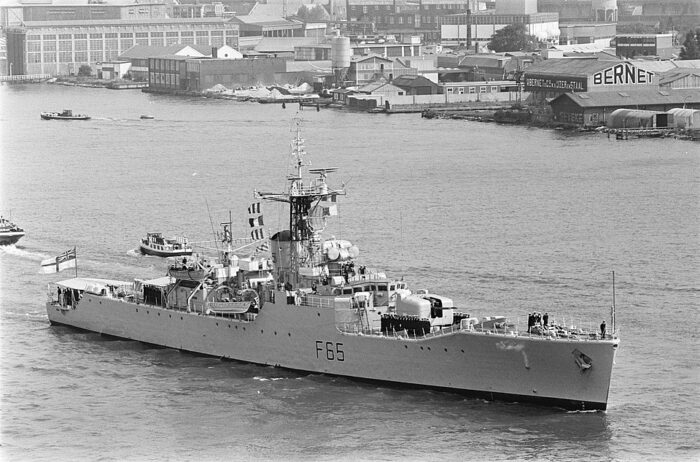
Design Development
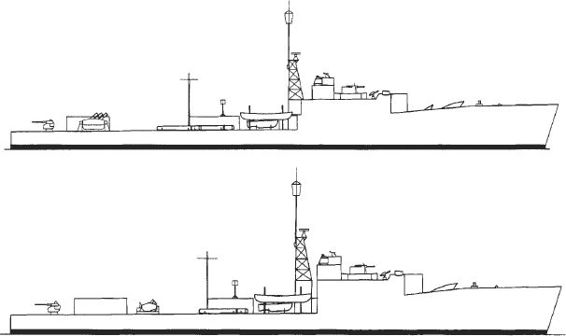
Type 17 3rd rate Frigates proposal, June 1950, Drawings by John Roberts via erenow.org, src below
A long genesis 1945-1947
In this long development towards the “perfect frigate” (which in many ways was the Leander class), started with the 1945 New Construction Programme. It originally incorporated plans to build four new escorts, but was scaled down to two ships as experiments, one anti-aircraft and anti-submarine. The Cabinet approved this in November 1945, but debate in the Naval Staff resulted in a single anti-submarine and one aircraft-direction frigate to be laid down in 1946. It was delayed to January 1946 wit increased dimension for the AA direction frigate at 1750t due to the new machinery for 20kts while the ASW frigate was to be 25kt capable bt this was not implemented due to production flexibility. The idea was to have an universal design that could be mass produced at a later stage in wartime. But it vecame soon very complex.
So by March 1947, that need for a perfect standardised hull was still questioned and at least there was agreement over a diesel machinery for the Staff Requirement of 4500 miles at 15kts compared to the weight of the machinery and fuel up by 800 tons. There was also a shortage of steam turbine sets at the time and in April a revised hull design using diesel later became the Leopard and Salisbury classes. The Admiralty instituting Type Numbers to keep pace with the new proposal, standard by July 1950. The classification system started with 11 and following for antisubmarine frigates, 41 and else for anti-aircraft ones, 61 and next for aircraft-direction frigates. Destroyers were classed as such if capable of 30 kts fleet speed, sloops if below 20 kts.
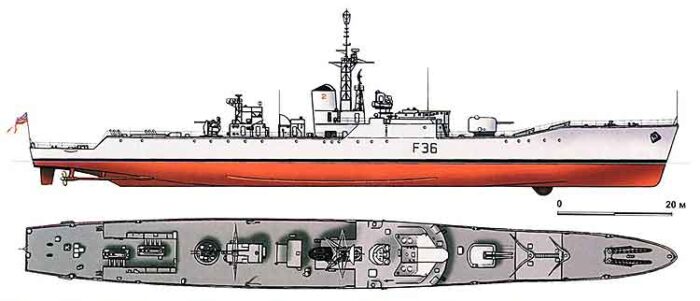
In March 1947 was initiated the Type 15 emergency ASW conversion program, which led many bases for the later Type 12. The main cause was the reveal of 1949 mass produced advanced soviet submarines of the Project 613 “Whiskey class” and that estimations in 1949 of a lack of proper ASW frigates capable of dealing with these imposed drastic measures. The Type 15 was groundbreaking in its brand new, very low, structure, thanks to the inpiraration of Assistant Director N G Holt which incorporated an aluminium forecastle extended well aft, which meant the yards had to produce the largest aluminium structure afloat. The structure was aiming at deflection rather than stres but since it was done on an existing steel structure there was the danger of electrolytic corrosion, solved by welding a steel bar flat to the deck, bolting/riveting the aluminium to it using insulating material. The design was very successful but took about two years for £600,000 which was seen as esxcessive at the time and led to austere Type 16 “limited” conversions.
Design of the Type 12
Until the end of 1947 the anti-submarine frigate was defined as 25kts capable out of 20,000shp, and range 3000 miles at 15kts. By early 1948 this became 27kts and 4500 miles at 15kts. Already to get there was an evolution from the Loch class capable of dealing with 7kts+ WW2 U-Boat designs with the Loch class, then to design the Intermediate ‘B’ Type Submarine or Porpoise class as 17–18kts hunter killers, and thus requiring a 27kt frigate as counter, then the British HTP test submarines (Explorer class) capable of 25kts underwater, as a comparison to potental Soviet subs using such German WW2 Walter boat tech. This imposed a top speed of 35kt, that no realistic frigate design could reach. It would 10 years to overcome this threat, reinforced by SSNs in 1960, with helicopters. So in the meantime, the Board of Admiralty wanted an upgraded design for the “B” Type threat so 27 knots.
Initially work was slowed by focus being given on the Type 14 conversions and the 1st-rate design was proposed to be delayed by 5 years until rejected and in February 1950 the Sketch Design for the Type 12 was ready for approval at the Board of Admiralt with a standard displacement of 1840 tons, 30,000shp thanks to the new Y100 steam turbines that were proposed in between by Vickers. Endurance was however slacked down from 4500 miles at 15kts to 12kts. It was planned for them a double Squid, but over time it was changed for a double Limbo as well as anti-submarine torpedoes, still being developed (and never fielded). Agreement on a twin 4.5in Mark VI was reached from the start but its development also took much longer than planned, as the new 3in/70 mounting. The first radar planned was the Type 277Q for height finding, Type 293Q for target indication, Type 262 for AA fire control, Type 275 for long-range AA fire control and sonar sets Types 162, 170 and 174, then Type 177.
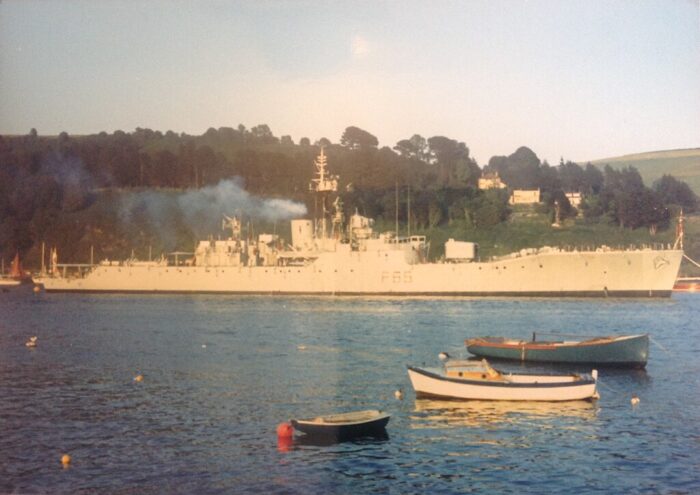
Color photo of HMS Dartmouth in 1972
The final design of the Type 12 was initiated after the cancellation of the Type 11 Diesel powered anti-submarine frigate, based on hull of Type 41 Leopard and Type 61 Salisbury classes. They shared a lot of similarities externally, but were designed for completely different roles. The core requirement for the Type 12 was the capability to steam for long periods of time in heavy seas and stay economical, while being capable of high speed chases, for submarines estimated capable of 20+ knots underwater. Unlike the legacy River class, still around at the time but now too slow for the new generation of Soviet submarines, the British Admiralty had now the luxury of ordering new ASW escorts from Naval Yards, not civilian ones as was the case for the Rivers and Flowers. This enabled the construction of more complicated and much refined hull forms, military grade equipment integrated from the start, and the size and appareance were perfectly suited for the role, resulting in smaller ships than the converted Type 14 in particular, still sharing a number of elements.
The design also diverged from the contemporary Type 41 and Type 61 design. The hull had the fine lines of a destroyer, yet with a preculiar raised forecastle with considerable flare and sloped cut to the main deck, then bevelled to a lower aft deck. The forecastle deck was levelled to maintain a maximum freeboard aft of the stem and break waves, but the remainder of the deck was lower and lighter. These features allowed to cut through waves, minimize spray, thrown upwards and outwards and away from the bridge and gun turret in high latitudes and especially for the north Atlantic winter, with ice building-up rapidly an dangerously. This was also an odd return to the old WW1 “toothbrush” design still enabling a low and light hull.
The deck edges met the hull with curves rather than angles, and the anchors were recessed, with protrusions were kept to a minimum, to limit all possibility of ice building-up or spray generation. There were many similarities in this with the Canadian earlier destroyer escort designs like the earlier Saint Laurent class, that may have been an inpiration. Launched in 1951 but studied from 1948, they were also tailored for the rough North Atlantic winter.
The Type 12 frigates still had a surface/dual armament, featuring a Mark 6 large and heavy gunhouse, carried low to maintain stability also clearing the view from the bridge behind, shiwh also sat low.
Stability was indeed clearly an imperative in heavy weather. The forecastle’s distinctive kink enabled these features with the added benefit of moving the bridge aft, closed to the balance center of the ship, in which there was considerably less motion, easing the watchkeeper’s work. The hull form was completed by a twin-shaft double-reduction geared steam turbine plant Y-100 which like late destroyers operated at high temperature and pressure for efficiency, but low revolutions. This was completed by brand new five-bladed low-cavitation propellers both for efficiency and quietness, but still capable of high-speed all-weather ASW chases.
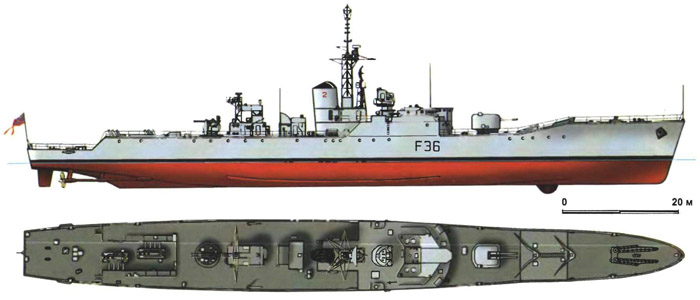
Experience with the Type 15 frigates conversions led to the adoption of a new bridge design that would be the trademark of Royal Navy escorts, up to the Leander class in 1969. This was a covered bridge, with a protruding small pilot’s position making its “T” shape. It was located right above the operations room. Whitby however featured a vertical face bridge while her sisters had their windows mounted at an angle to cut down on internal reflections inside the bridge at low light, evening and dawn. The good old open navigation bridge was still located above and behind this enclosed one, which can act as supplementary spray/wave breaker and somewhat protect it.
The initial designed funnel was straight and cylindrical at first. Since the Whitby class, like other contemporary desigs of that time was NBC-proof, the funnel was supposed to resist a nuclear blast, but prone to down-draughting and did not managed to clear hot exhaust gasses efficiently, so it was replaced by a heightened and raked as well as streamlined funnel with a domed top as completed. This was also adopted by the following Rothesay class. HMS Scarborough was the only only one keeping that stubby vertical funnel in service.
Construction:
Overall eifght ships of this design were built: Six for the Royal Navy and two for the Indian Navy: Construction time was very long (6-7 years) for such “small” ships due to design revisions and budget restrictions. A stard contrast to the WW2 naval construction pace of barely a year and half. In contrast, the Indian ships, ordered several years later, were built in just 2 years.
It should be noted that these ships were trailblazer and successors designs, such as the Rothesay were faster to build. But in 1960, the Soviets started to introduce their first SSNs and the Type 12 design was already challenged.
F43 HMS Torquay at Harland & Wolff Ltd, Belfast, started in March 1951 but commissioned in May 1956.
F36 HMS Whitby at Cammell Laird and Co Ltd, Birkenhead (February 1951/July 1956)
F63 HMS Scarborough at Vickers Armstrongs in Newcastle upon Tyne and completed in Barrow-in-Furness (March 1951/May 1957)
F65 HMS Tenby at Cammell Laird (March 1951/December 1957)
F73 HMS Eastbourne at Vickers Armstrongs/Newcastle upon Tyne/Barrow-in-Furness (March 1951/January 1958)
F77 HMS Blackpool at Harland & Wolff (March 1951/August 1958)
F140 Talwar at Cammell Laird (June 1957/April 1959)
F143 Trishul at Harland & Wolff (February 1957/January 1960).
Design of the class
Hull and general design

The Type 12 with all the points seen above measured 360 ft (110 m) at the waterline, 370 ft (110 m) overall so almost like WW2 destroyers, on a relatively similar beam of 41 ft (12 m) and a draught of 17 ft (5.2 m) displacement for a relatively measured displacement of 2,150 tons (2,185 tonnes) standard and 2,560 tons full load (2,600 tonnes). The hull design was simplified as the number of longitudinals was reduced. A shape developed by N G Holt and R W L Gawn with high freeboard carried aft plus deep draught, fine lines for pushing the centre of buoyancy well aft. To maintain stability when fuel was consumed there was a system of water ballast tanks under the fuel tanks with water being admitted through pumps as fuel was used up to always maintain the same level. That feature was based on practical experience at sea and tests by Gawn at the Admiralty Experiment Works in Haslar. Note the very peculiar hull shape forward, especially seen from above. It was done for the finest forward waterline entries possible, making the best of the powerplant. The beam was mostly concentrated amidship and aft, ending with a relatively large transom stern.
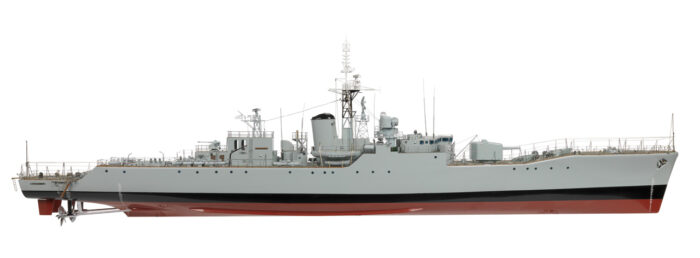
HMS Londonderry, Rothesay class, yard model at Greenwhich coll. IWM
The Type 12 frigate like the Types 41 and 61 had raised fore end with fine lines forward, with a balance point further aft to accomodate the large-diameter gun bay for the forward twin 4.5in Mark VI gun bay if placed well aft. The bridge was pushed much further aft indeed because of the fine waterline entry lines. The low assisted stability and enabled an equally low bridge amidships, so for the watchkeepers to have an easier ride. This made at least from their own point of view these ships good sea-boats. The Type 41 and 61 classes had fuller lines but overall ended in a roughly similar profile. The later Type 23 frigate ended with a modified design by D.K. Brown.
Powerplant
The raised fore end also appeared perfect to house the diesel generators, located now as far as possible from the turbo generators, in a good compartimentation for survivability. The diesel exhaust hiever ruined the paint and this was modified for the Leanders, relocated in the mast. The Type 12s had twin rudders in the propeller slipstream as it was found to boost performance in turning circle, which was just three a a half the her hull length. For silent approaches, the 7-bladed propeller in addition was low-running (220rpm) and 12ft wide compared to destroyer’s usual 10ft 6in diameter. This made them roughly twice as quieter, a feature also adopter for submarines later.
The Propulsion was the new Y-100 plant that was promoted for this design as an evolutionaty step, using two Babcock & Wilcox boilers feeding two English Electric steam turbines via generators for extra flexibility. The output was 30,000 shp (22,000 kW) whihch gave 30 knots (56 km/h), so more than the 27 unitially planned, but this was only on trials, light, and for a short time. On standard runs, 27 knots was indeed more common. Range had been compromised for this as the Type 12 carried 370 tons oil fuel, making for a still appreciable 4,200 nmi (7,780 km) at 12 knots (22 km/h) instead of 15.
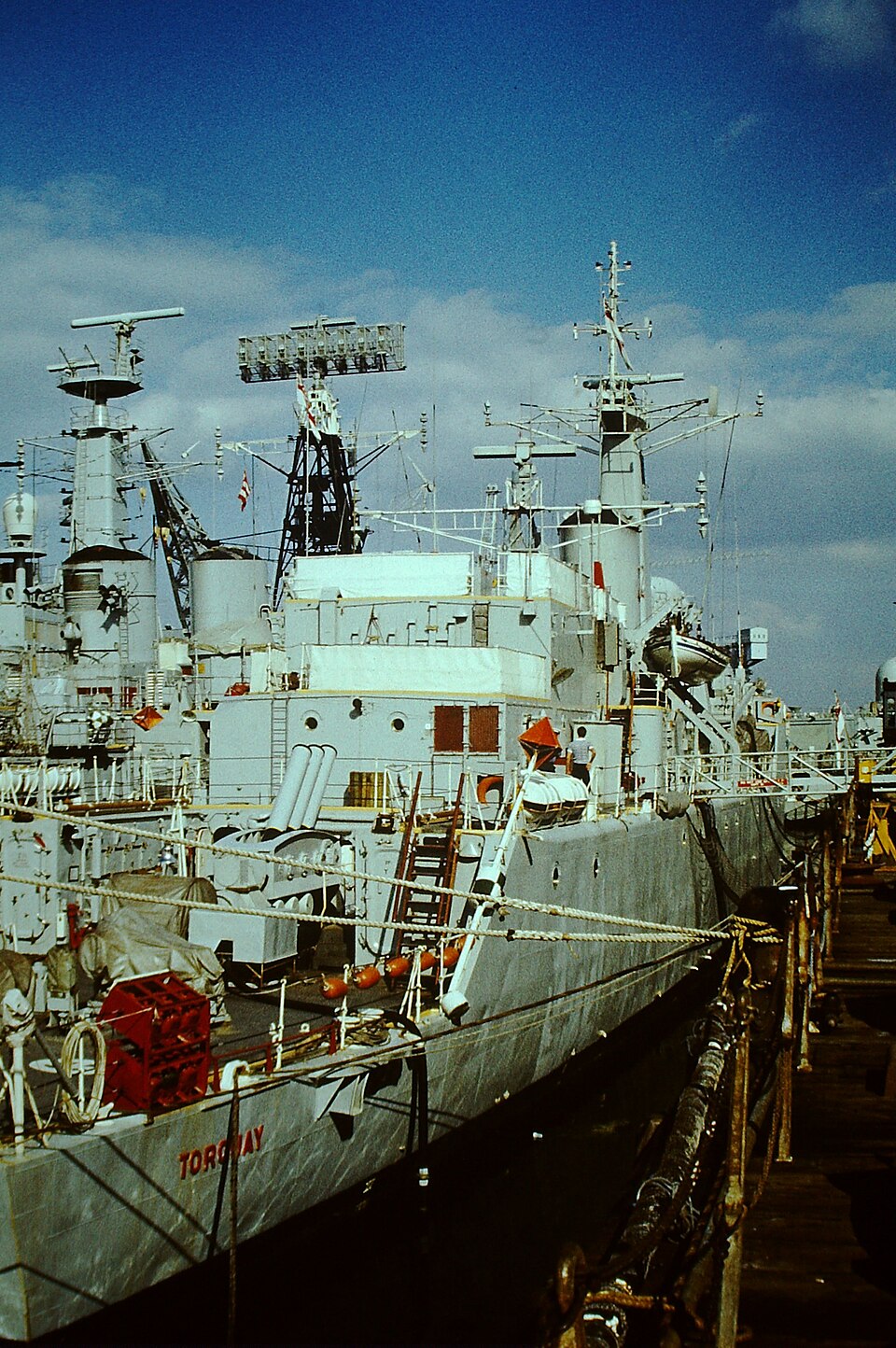
Stern view of HMS Torquay
Armament
The armament relied on the two Limbo Mark 10 anti-submarine mortars aft in a well on the quarterdeck for better protection from the elements. The system is geared to fire at any time a three-bomb salvo above and below the target, and create a convergent pressure to make a sure kill. The systems had a 360° arc of fire. Unlike previous WW2 vessels which had their hedgehogs forward, having the main ASW weapons relocated aft left more space for the heavy but useful 4.5 inches twin turret, usable for naval bombardment as well. In complement there were bo less than twelve fixed, non-reloadable 21-inch Mark 20E “Bidder” homing torpedoes.
AA defence mostly rested at shorter ranges on the STAAG complex, which later appeared as a failed system.
4.5-in (113 mm) Mark 6 gun mounting
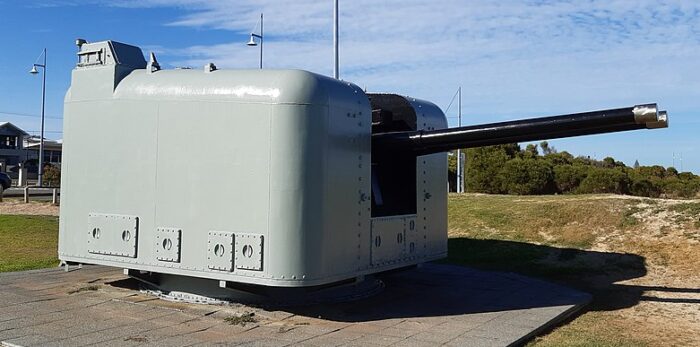
The 4.5 inches was an old system, entering service in 1938, but updated several times. The Mark 6 started development in 1944 as a twin gun system encased on a boxy looking twin turret. It was widely used by Australia, the RN and New Zealand. Basically a postwar British version of the US 5-in/38, it boasted superior capabilities. The system was developed to be high elevations, automatic aiming for a fast rate of fire. It introduced a loading tray and rammer pushed clear of the gun’s axis by the vertically closing breech block whole Ammunition was supplied by two magazines with separate shell hoist for AA or HE/SAP and a third suppliying cartridges.
⚒ Specs
Weight 6,304 lbs. (2,859 kg) with breech mech. 241.25 in (6.128 m) oa.
Rate Of Fire as designed 24 rpm, practical manual 12-14 rpm, Burst 18 rpm.
Separate ammunition, 55 lbs. (25 kg) HE/SAP/AA, charge 11.04 lbs. (5.0 kg) SC 122 13.63 lbs. (6.18 kg) NF/S 198-054
Brass 114 x 645 mm 27.0 lbs. (12.2 kg) cartridge
Muzzle Velocity 2,449 fps (746 mps) at 20.5 tons/in2 (3,230 kg/cm2), barrel life 650 rounds.
Twin 40mm Bofors Mk.2 STAAG
The acronym STAAG stands for Stabilised Tachymetric Anti-Aircraft Gun. consisted of two Bofors 40 mm L/60 guns, the radar Type 262 fire control set and a tachymetric computer. All this was carried on a common, stabilised, powered-operated gun mounting. Intended to function much as the modern close-in weapon system does, this weapon was ahead of the limits of technology at the time; it was overweight and overly complex and its sensitive valve electronics were a maintenance nightmare. Ultimately STAAG would be replaced by a simple and ubiquitous Bofors 40 mm gun on the single Mark 7 mounting.
The Bofors was still an efficient beast of burden of early AA protection, capable of a range of 7,160 m (23,490 ft), 120 round/min at high elevation angles (fed by clips) at a muzzle velocity of 850–880 m/s (2,800–2,900 ft/s). These were later removed and a single Mark 7 installed.
Limbo ASWRL
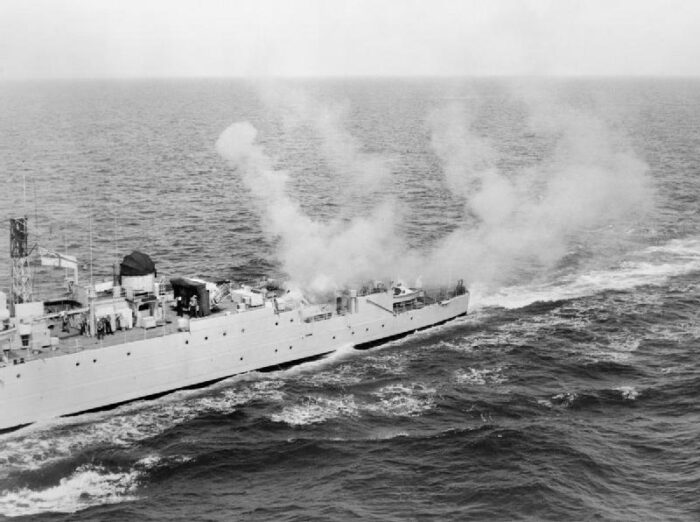
Developed in 1950 as replacement for the Squid they were widespread in these early generation ASW frigates. They equipped also the Austrlian Daring class DDs, updared cold war River class frigates, most RCN destroyers, and the SAF President class Frigates. The mounts could traverse fully, the three mortars could be angled up and down and fire a 12 inches (30 cm) 400 lb depth charge from 400 yards (366 m) to 1,000 yards (914 m). The 94 kilograms (207 lb) Minol Warheadcould use both proximity and/or time fuse, and the whole system was slaved to the Type 170 sonar for traverse and bearing to gain reaction time. It created a pattern of three explosive charges roughly around the expected target location, creating a combined pressure wave with devastating effects. The Limbo remained active until the 1980s.
21-inch Mark 20E “Bidder” Torpedoes
Four pairs, fixed firing forward on either beam, with a trainable pair behind these on either side for sixteen total. They were passive-seeking and battery-powered but the Mark 20E was heavier than the 20S for submarines, and performances were degraded at 15/24 instead of 20 knots, having a dual-speed mode for target search and attack. Range was 18,000 meters at 15 knots, 5,500 at 24 knots. Even Whiskey class coud escape these the best of times. They were planned to equip both the Rothesay and Whitby class. Programming of the torpedo was also problematic. On the long run, the Mark 20E (for “Escort”) appeared as a failure. They were no fast enough to catch their preys. The tubes were removed soon after entering service or not fitted at all, no torpedoes never carried in practice.
Sensors
The Limbo system was controlled by three sonars: Type 174 (search), Type 162 (target classification), Type 170 “pencil beam” for targeting.
The lattice foremast sported the Type 293Q target indication set, Type 974 navigation set, Type 277Q height finder (on a stump mast between bridge and mainmast).
These sets came from Second World War designs.
The 4.5in Mark 6 gun was controlled by a Mark 6M director and Type 285 radar mounted behind the bridge.

Conway’s depiction of HMS Rothesay
⚙ Type 16 specifications |
|
| Displacement | 2,150 tons (2,185 tonnes), 2,560 tons full load (2,600 tonnes) |
| Dimensions | 370 x 41 x 17 ft (110 x 12 x 5.2 m) |
| Propulsion | 2 shafts EE GST, 2× B&W boilers 30,000 shp (22 MW) |
| Speed | 30 knots (56 km/h) |
| Range | 370 tons oil fuel, 4,200 nmi (7,780 km) at 12 kts (22 km/h) |
| Armament | 1×2 4.5 in (113 mm) gun Mark 6, 2×2 40 mm Bofor M2 STAAG, Limbo ASW Mark 10, 12 × 21-in ASWTT |
| Sensors | Type 293Q TI, Type 993, 277Q HF, 275 FCS M6M, 262 STAAG, 974 Nav, Type 1010 Cossor Mark 10 IFF, Type 174, 162, 170 attack |
| Crew | 152, later 225 |
Career of the Withby class
The Whitbys were no upgraded like the Rothesay, and only active for about 15 years in the 1970s between age and defence economies. In 1966 already, HMS Blackpool was loaned to the Royal New Zealand Navy before the delivery of the Leander class HMNZS Canterbury, and withdrawn in 1971. All others except Eastbourne and Torquay were decommissioned in the 1970s, last two in 1984 and 1985. Scarborough and Tenby were for a time considered for purchase by Pakistan, but they needed costly refits and the order was cancelled. HMS Blackpool ended as a target ship in the Firth of Forth, HMS Eastbourne was rammed in the Third “Cod War” in 1976 and no longer saw servove albeit her steam turbines were in good condition: She became a static engineering training ship at HMS Caledonia, at Rosyth. Torquay tested the new Computer Assisted Action Information System (CAAIS) for trials and acted also as training ship.
 F43 Torquay
F43 Torquay
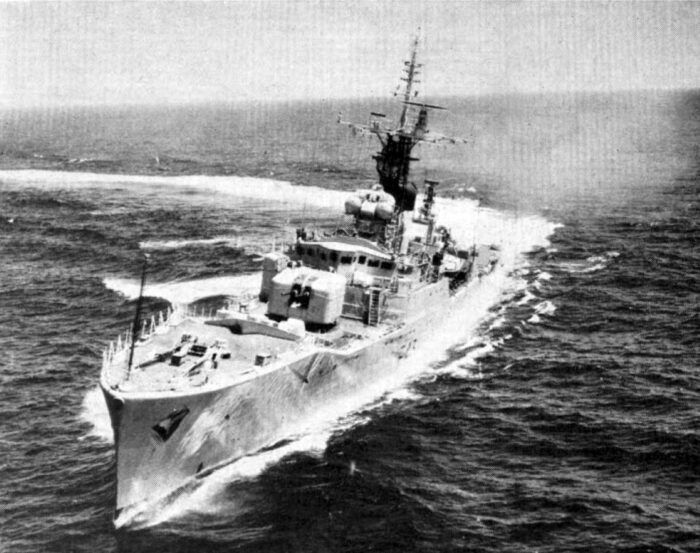
HMS Torquay was ordered to Harland & Wolff Ltd, Belfast on 6 March 1951, laid down at 11 March 1953, launched on 1 July 1954, and commissioned on 10 May 1956 at a cost of £2,769,000. On commissioning she joined the 5th Frigate Squadron in Portsmouth as leader on 28 August. Fist deployment was in the Mediterranean by late October, Suez operation in November 1956, patrolling Cyprus in 1957, back on 16 May. By July 1958 she took prt in Operation Fortitude, the airlift from HMS Eagle to Jordan after a request of King Hussein due to unrest after the formation of the United Arab Republic by Egypt and Syria and 14 July Revolution in Iraq. From 1963 to 1971 she remaind with the Dartmouth Training Squadron. From 1972 to 1985 she became a navigation training ship in Portsmouth. In 1971 she had an overhaul and was fitted with a solid main mast, large training navigation room rplacing a set of mortars and installation of CAAIS. She took part in the 1977 Silver Jubilee Fleet Review off Spithead while in the 2nd FriRon. She was replaced by HMS Juno, paid off on 23 March 1985, sold for BU 1987 in Barcelona, last in class to leave service.
 F36 Whitby
F36 Whitby
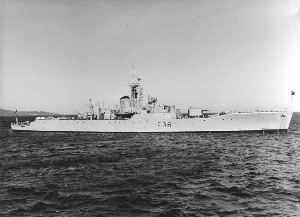 HMS Whitby was laid down at Cammell Laird’s Birkenhead shipyard on 30 September 1952, launched on 2 July 1954 and completed on 10 July 1956, assigned to the 3rd Training Squadron at Londonderry. In 1960 under Desmond Cassidi she saw service in the Mediterranean (1966) and Atlantic. In 1968 she was in fishery protection duties off Greenland (code wars) and in 1968 to ‘Navy Days’ at Portsmouth. Decommissioned in 1974 she was laid up, waiting for a potential sale to Pakistan which was cancelled. She was Sold for scrapping in 1979.
HMS Whitby was laid down at Cammell Laird’s Birkenhead shipyard on 30 September 1952, launched on 2 July 1954 and completed on 10 July 1956, assigned to the 3rd Training Squadron at Londonderry. In 1960 under Desmond Cassidi she saw service in the Mediterranean (1966) and Atlantic. In 1968 she was in fishery protection duties off Greenland (code wars) and in 1968 to ‘Navy Days’ at Portsmouth. Decommissioned in 1974 she was laid up, waiting for a potential sale to Pakistan which was cancelled. She was Sold for scrapping in 1979.
 F63 Scarborough
F63 Scarborough
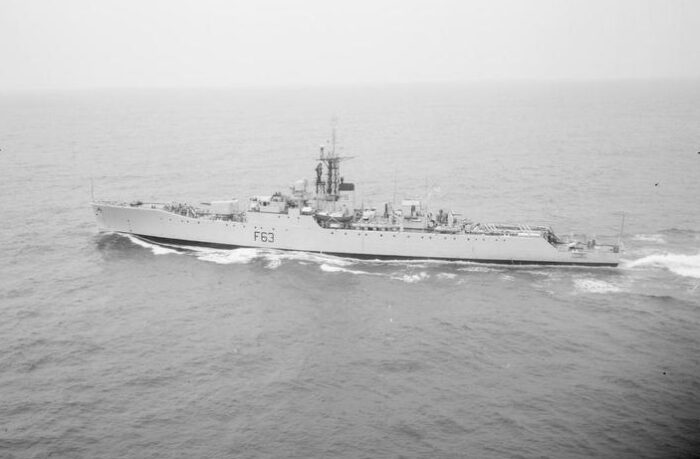
HMS Scarborough was ordered on 6 March 1951 to Vickers Armstrongs, Newcastle upon Tyne, named after the town of Scarborough in the county of North Yorkshire. She was laid down on 11 September 1953, launched on 4 April 1955 and commissioned on 10 May 1957. She joined the 5th Frigate Squadro as leader of the squadron in March 1959 taking part in “Navy Days” in Portsmouth she was under command ofJózef Bartosik Between 1959 and 1961 then P W Buchanan between 1961 and 1962. She had an extended refit at Portsmouth (December 1962-February 1964). From April 1964 she entered the Dartmouth Training Squadron with Eastbourne, Tenby and Torquay. She was Decommissioned 1972, Sold to the Pakistan Navy in 1975 but not taken up, as the sale was cancelled. She was sold for scrapping in 1977.
 F65 Tenby
F65 Tenby
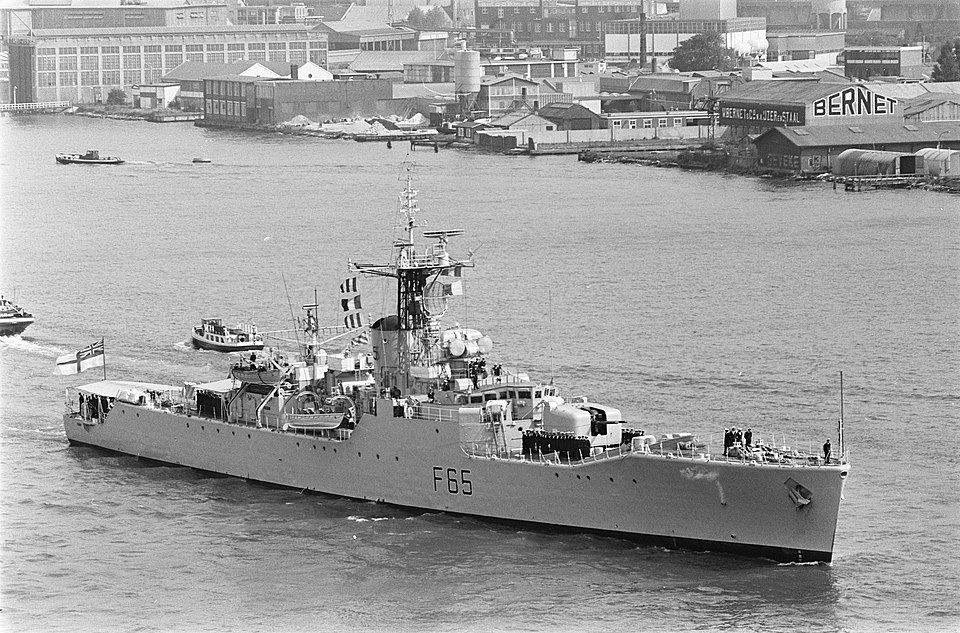
HMS Tenby in Amsterdam
HMS Tenby was ordered to Cammell Laird and Co Ltd, Birkenhead on 6 March 1951, laid down 23 June 1953, launched on 4 October 1955, and completed on December 1957 for £2,822,000. In 1962-1963 she was under command of Captain T Lewin. She was one of three frigates part of the Dartmouth Training Squadron, training Officer Cadets before being promoted to Midshipmen. She starred in the fake military funeral of Commander James Bond in 1967 “You Only Live Twice” filmed on board near Gibraltar (in Hong Kong in the movie). She was paid off into the reserve fleet on 8 December 1972 with the crew leaving her on 28 February 1973, spent four years laid up at Devonport and was sold to Thos. W. Ward (Briton Ferry) for scrapping on 1979 after the failure of the proposed sale to Pakistan, which was cancelled.
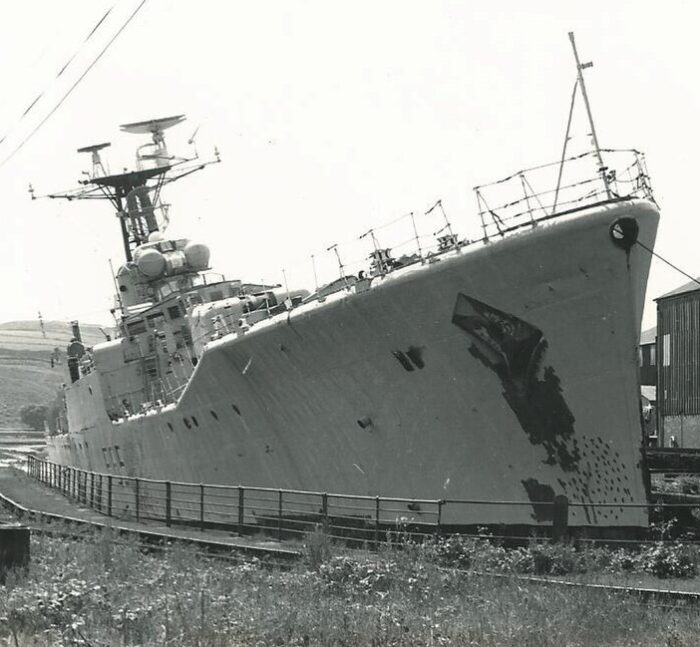
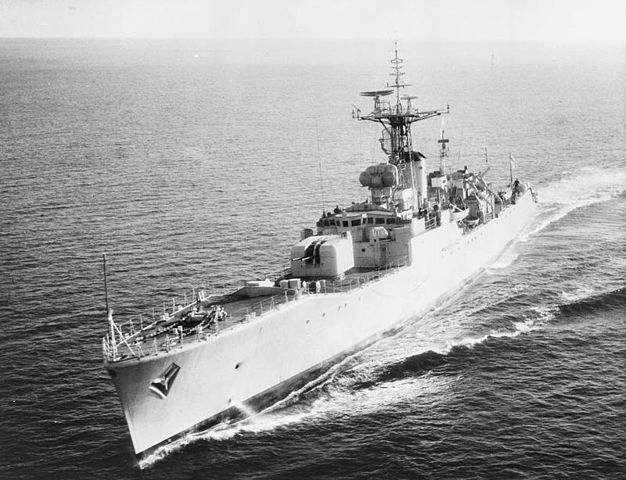
 F73 Eastbourne
F73 Eastbourne
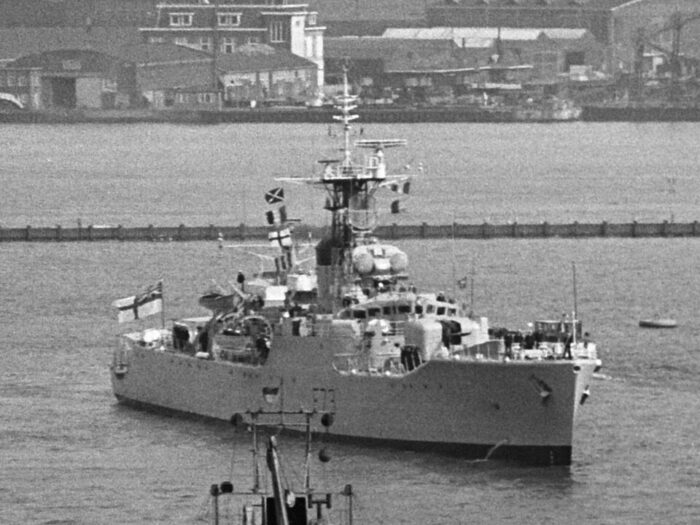
Ordered to Vickers Armstrongs (Shipbuilders) Ltd at High Walker, Newcastle upon Tyne up on 6 March 1951, laid down 13 January 1954, launched on 29 December 1955, she was fitted out at Vickers Armstrongs (Shipbuilders) Ltd, Barrow-in-Furness until completion by January 1958, officially commissioned on 9 January 1958 for £2,774,000. She was assigned to the 3rd Training Squadron in Londonderry, Northern Ireland and in August loaned to the Fishery Protection Squadron as flagship, Commodore, Fishery Protection Squadron (CFPS) in the First “Cod War” off Iceland until 1 September 1958. She was there with Russell and Palliser and the minesweeper Hound to protect British trawlers. Eastbourne preventing several British trawlers from being arrested by Icelandic gunboats while capturing two Icelandic boarding parties. While backed she stopped at Eastbourne, and to Odense, Denmark, Stockholm, Sweden and Brest. By June 1959 she was assigned to the the 4th Frigate Squadron, Mediterranean. In 1966 she became leader of the Dartmouth Training Squadron.
In 1972 she replaced HMS Rapid as training ship for the artificer apprentices, establishment HMS Caledonia for 14 weeks aboard ship, training general engineering before the examinations of auxiliary machinery certificates. She was part of the Queen’s Jubilee Fleet Review.
In 1976 Eastbourne she returned to Icelandfor the third “Cod War” and by 22 May, damaged in a collision with ICGV Baldur. She was repaired in Rosyth in 1977, but a hull inspection she was unfit for sea, hull rusty but machinery in good condition. She had her propellers removed, ‘brake wheels’ fitted and used by apprentices in machinery training, including at full power in the dockyard basin. She was used by Royal Naval Engineering College Manadon and remained at Rosyth Dockyard alongside Duncan as harbour training ship in the 1980s. When Caledonia was scheduled to close, Eastbourne and Duncan were paid off for disposal in March 1984. She was sold for scrapping in 1985.
 F77 Blackpool
F77 Blackpool
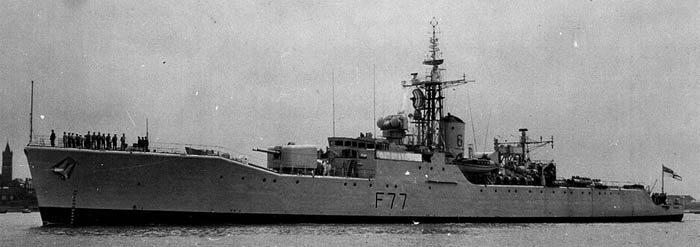
HMS Blackpool was ordered to Harland & Wolff Ltd, Belfast on 6 March 1951, laid down on 20 December 1954, launched on 14 February 1957 and completed on 14 August 1958 for £3,269,000.
She became leader of the 6th Frigate Squadron 1958-1960 under command of Edward Ashmore. Between 1962 and 1964 she was assigned to the 25th Escort squadron with HMS Rothesay, HMS Cavendish, HMS Brighton, and HMS Llandaff which was their Canteen boat. The flotilla spent 12 months east of Suez, 6 months at home, 6 months in the Far East. In 1964-1966 she was leader of the 28th Escort Squadron. She was then leased to the Royal New Zealand Navy from 7 June 1966 to 30 June 1971. In 1969, she was present at the Melbourne-Evans collision and came in assistance. Returned in 1971, she was paid off and placed in reserve until sold for scrapping in 1980.
 F140 Talwar
F140 Talwar
INS Talwar was ordered and laid down to Cammell Laird on 7 June 1957, launched 18 July 1958 and comissioned on 26 April 1959. She which served in the Portuguese-Indian War and the Indo-Pakistani War of 1971. She was paid off 30 October 1985, BU in 1992.
 F143 Trishul
F143 Trishul
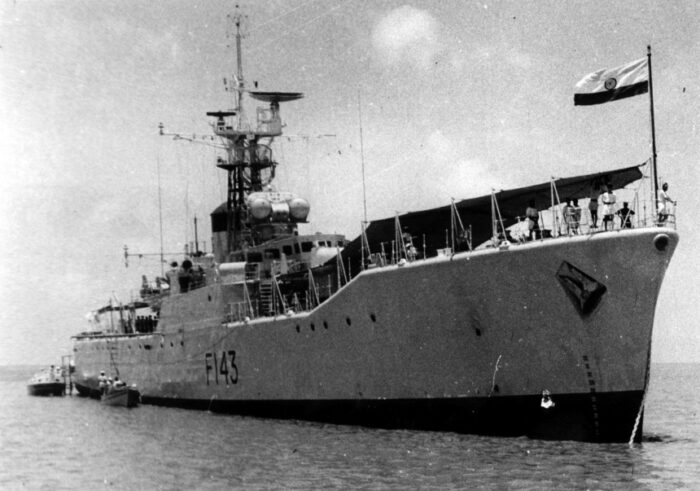
INS Trushul (src shipshub)
INS Trishul was laid down at Harland & Wolff on 19 February 1957, launched on 18 June 1958 and commissioned on 13 January 1960. She served in the Portuguese-Indian War and Indo-Pakistani War of 1971. She was a TS until ^paid off 31 August 1992, broken up c1996, very last of the class ever afloat.
Succession: The helicopter-capable Rothesay class
The admiralty still neeeded to answer the “C” underwater treat, requiring a 1st rate 35 knots capable ASW frigate, but it was just unfeasible given the initial sets of constraints, and only helicopters, still being developed in 1950, became the answer. This led to the design of the improved Type 12 or Rothesay class, which for the first tule integrated an aft hangar when refitted. This led to the “universal” Leander class design in the 1960s.
Soon after the Board of Admiralty approved the Sketch Design for Type 12, the six Whitby class were delivered, and later nine in slightly modified versions called the Rothesay class for the Royal Navy. Two more were built for India, three modified for South Africa, then four in Australia. The Rothesay’s main feature (before the helipad) was to integrated the first frigate borne-SAM, the Sea Cat. This new class also got rid of its cruising turbines and were all later rebuilt to Leander standards (hence the helipad and other features), not the original Whitby which had their hull plating replaced due to corrosion but few modifications otherwise.
Read More/Src
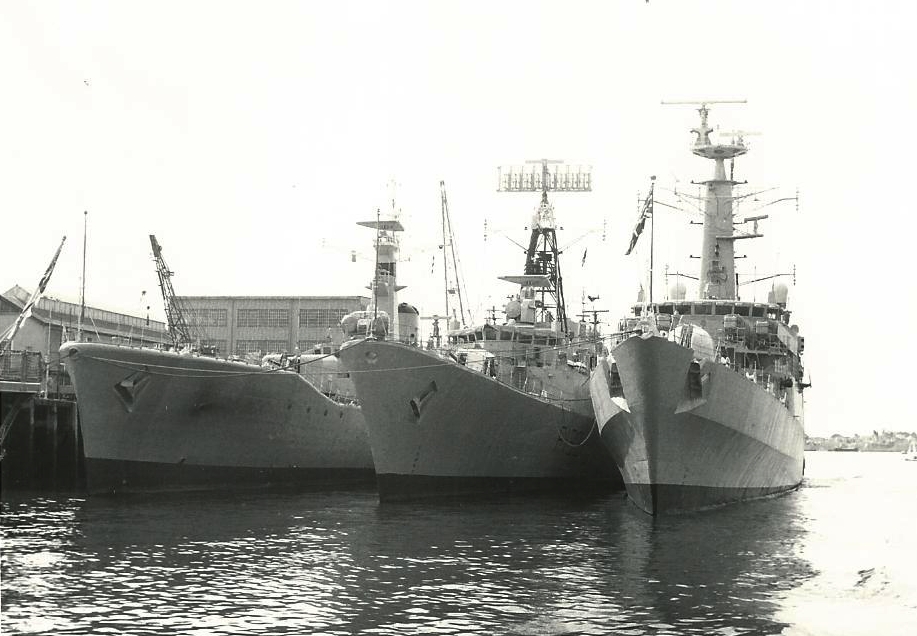
Torquay, Tartar and Active at the Portsmouth Navy Day
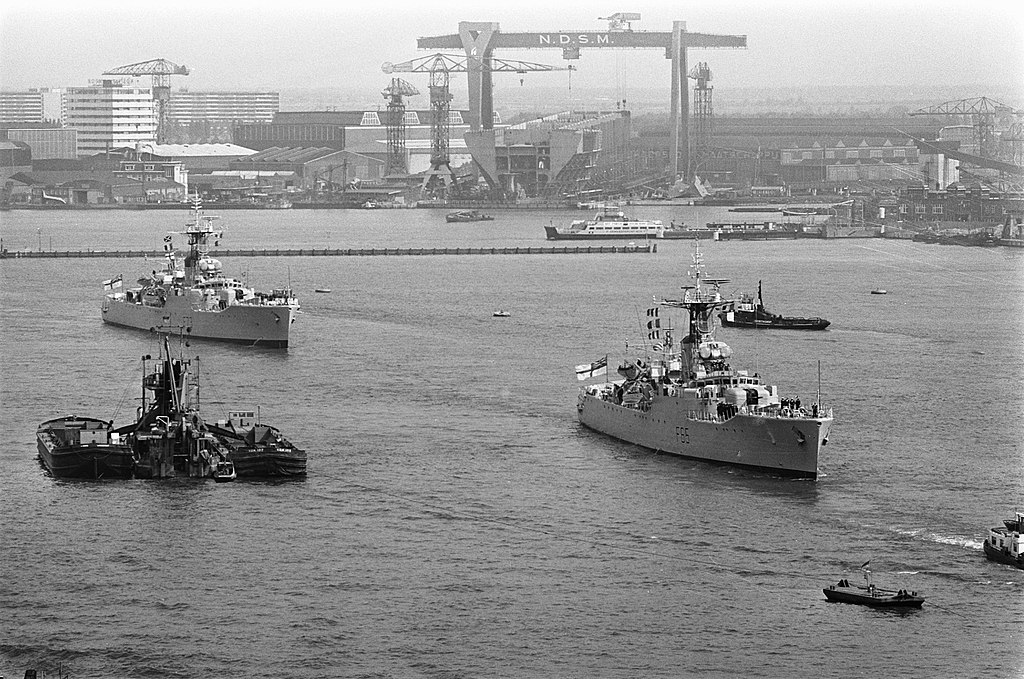
Two Whitby clas Frigates in Amsterdam
Books
Conway’s all the world’s fighting ships 1947-95.
Colledge, J. J.; Wardlow, Ben & Bush, Steve (2020). Ships of the Royal Navy. Barnsley, UK: Seaforth Publishing.
Royal Navy Frigates 1945-1983″ Leo Marriott, Ian Allan, 1983.
Moore, George, “The dawn of the Salisbury, Leopard and Whitby class frigates” in Warship, 2004, Conways, 2004
Purvis, M.K., “Post War RN Frigate and Guided Missile Destroyer Design 1944–1969”, Transactions of the Royal Institution of Naval Architects 1974
Marriott, Leo, Royal Navy Frigates Since 1945, Second Edition, Ian Allan, Surrey, 1990
Colledge, J. J.; Warlow, Ben (2006) [1969]. Ships of the Royal Navy, Complete Record, Chatham Publishing.
Capt. John E. Moore, Warships of the Royal Navy; New Edition, Jane’s Publishing, 1981.
D. K. Brown & George Moore, Rebuilding the Royal Navy. Warship design since 1945, Chatham Publishing, 2003
Links
erenow.org/
en.wikipedia.org/
shipshub.com/
hazegray.org
alchetron.com HMS-Torquay
hmsscarborough.info/
navweaps.com 4.5in 45 mk5
on flibusta.site
Model Kits
On scalemates.com/
Many kits: FROG 1:500, Novoexport 1:500, Ogonek 1:500, Novo 1:500, ZTS Plastyk 1:500, Atlantic Models 1:350, HMNZS Blackpool Model Monkey 1:500.

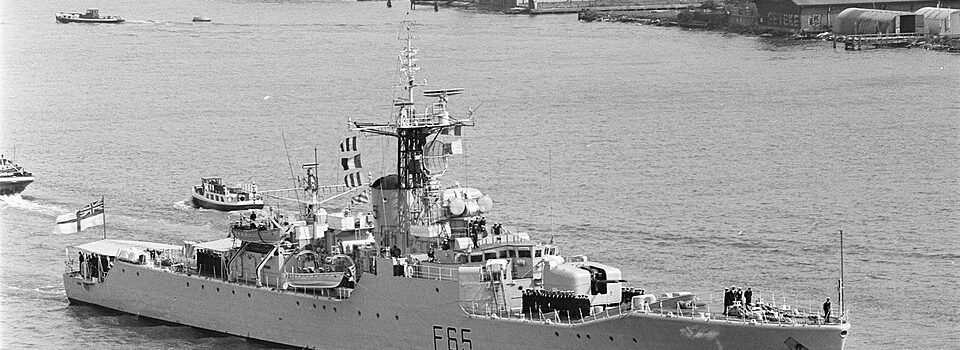
 Latest Facebook Entry -
Latest Facebook Entry -  X(Tweeter) Naval Encyclopedia's deck archive
X(Tweeter) Naval Encyclopedia's deck archive Instagram (@navalencyc)
Instagram (@navalencyc)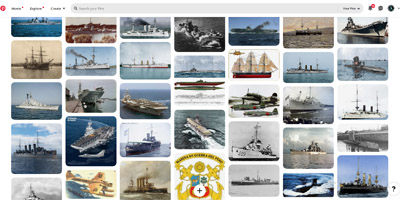

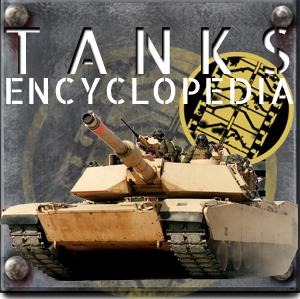
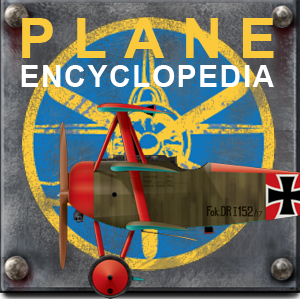
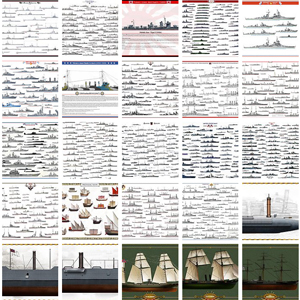
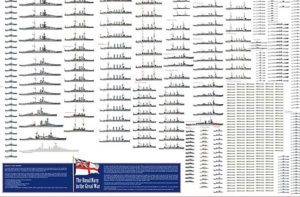
 French Navy
French Navy Royal Navy
Royal Navy Russian Navy
Russian Navy Armada Espanola
Armada Espanola Austrian Navy
Austrian Navy K.u.K. Kriegsmarine
K.u.K. Kriegsmarine Dansk Marine
Dansk Marine Nautiko Hellenon
Nautiko Hellenon Koninklije Marine 1870
Koninklije Marine 1870 Marinha do Brasil
Marinha do Brasil Osmanlı Donanması
Osmanlı Donanması Marina Do Peru
Marina Do Peru Marinha do Portugal
Marinha do Portugal Regia Marina 1870
Regia Marina 1870 Nihhon Kaigun 1870
Nihhon Kaigun 1870 Preußische Marine 1870
Preußische Marine 1870 Russkiy Flot 1870
Russkiy Flot 1870 Svenska marinen
Svenska marinen Søværnet
Søværnet Union Navy
Union Navy Confederate Navy
Confederate Navy Armada de Argentina
Armada de Argentina Imperial Chinese Navy
Imperial Chinese Navy Marinha do Portugal
Marinha do Portugal Mexico
Mexico Kaiserliche Marine
Kaiserliche Marine 1898 US Navy
1898 US Navy Sovietskiy Flot
Sovietskiy Flot Royal Canadian Navy
Royal Canadian Navy Royal Australian Navy
Royal Australian Navy RNZN Fleet
RNZN Fleet Chinese Navy 1937
Chinese Navy 1937 Kriegsmarine
Kriegsmarine Chilean Navy
Chilean Navy Danish Navy
Danish Navy Finnish Navy
Finnish Navy Hellenic Navy
Hellenic Navy Polish Navy
Polish Navy Romanian Navy
Romanian Navy Turkish Navy
Turkish Navy Royal Yugoslav Navy
Royal Yugoslav Navy Royal Thai Navy
Royal Thai Navy Minor Navies
Minor Navies Albania
Albania Austria
Austria Belgium
Belgium Columbia
Columbia Costa Rica
Costa Rica Cuba
Cuba Czechoslovakia
Czechoslovakia Dominican Republic
Dominican Republic Haiti
Haiti Hungary
Hungary Honduras
Honduras Estonia
Estonia Iceland
Iceland Eire
Eire Equador
Equador Iran
Iran Iraq
Iraq Latvia
Latvia Liberia
Liberia Lithuania
Lithuania Mandchukuo
Mandchukuo Morocco
Morocco Nicaragua
Nicaragua Persia
Persia San Salvador
San Salvador Sarawak
Sarawak Uruguay
Uruguay Venezuela
Venezuela Zanzibar
Zanzibar Warsaw Pact Navies
Warsaw Pact Navies Bulgaria
Bulgaria Hungary
Hungary

 Bundesmarine
Bundesmarine Dutch Navy
Dutch Navy Hellenic Navy
Hellenic Navy Marina Militare
Marina Militare Yugoslav Navy
Yugoslav Navy Chinese Navy
Chinese Navy Indian Navy
Indian Navy Indonesian Navy
Indonesian Navy JMSDF
JMSDF North Korean Navy
North Korean Navy Pakistani Navy
Pakistani Navy Philippines Navy
Philippines Navy ROKN
ROKN Rep. of Singapore Navy
Rep. of Singapore Navy Taiwanese Navy
Taiwanese Navy IDF Navy
IDF Navy Saudi Navy
Saudi Navy Royal New Zealand Navy
Royal New Zealand Navy Egyptian Navy
Egyptian Navy South African Navy
South African Navy






























 Ukrainian Navy
Ukrainian Navy dbodesign
dbodesign